– by Dede Horan
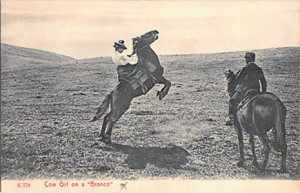 January is the month for cowboys and cowgirls, roping and riding, and showing of livestock. Yep, the much-loved National Western Stock Show is setting up in January. January is also the month of the much-awaited Denver Postcard & Paper Show. And if you’re interested in western-themed memorabilia then you’ll want to attend the postcard show.
January is the month for cowboys and cowgirls, roping and riding, and showing of livestock. Yep, the much-loved National Western Stock Show is setting up in January. January is also the month of the much-awaited Denver Postcard & Paper Show. And if you’re interested in western-themed memorabilia then you’ll want to attend the postcard show.
In the early 1900s through the 1950s, many postcards were produced that depicted cowboy life, rodeo scenes, cowboy humor, and even cowgirls. In this article, we’ll take a look at four western artists with distinctive styles each of whom has earned a place in the hearts of many collectors.
Charles E. Morris
Many of the early western themed postcards were produced from images of photographer, Charles E. Morris, who favored western scenes of South Dakota, Wyoming and his home state of Montana.
Morris had his time wrangling horses and herding cattle and later used a camera to show the open range of Montana. In 1904, he entered a photograph of a cowboy high in the air, taming a bucking bronco. This photo earned him a prize at the Centennial Lewis and Clark Exposition in St. Louis.
Some of Morris’ best photographs were produced on postcards which he had colorized through lithography in Germany. His postcards were the biggest selling postcards in Montana at the time.
The 1906 card shown here of a “Cow Girl on a Bronco” was produced by Morris. The focus is on the girl who is skillfully managing a rearing horse while a man watches. Nothing in the scenery distracts from the moment of action; although the scene is a staged one, it still captures the feeling of the times.
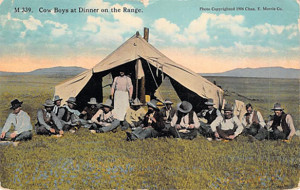 Two examples of photo-chrome cards are shown here. The cowboys gathered near the large cook’s tent is from a 1906 photograph by Morris. The card itself was produced sometime between 1908 – 1915. Again, aside from the mountains on the distant horizon, there’s nothing to distract from the gathering of men for a meal. Of course, there’s some staging here, too, with all the men facing the camera and the cook standing with hands by his sides.
Two examples of photo-chrome cards are shown here. The cowboys gathered near the large cook’s tent is from a 1906 photograph by Morris. The card itself was produced sometime between 1908 – 1915. Again, aside from the mountains on the distant horizon, there’s nothing to distract from the gathering of men for a meal. Of course, there’s some staging here, too, with all the men facing the camera and the cook standing with hands by his sides.
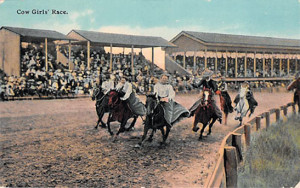 And here’s a view with some real action – a “Cow Girl’s Race.” Can’t you feel the excitement and hear the pounding of the hooves and the cheers from the crowd? There is no identification as to location or who took the photograph but it could be one by Charles E. Morris.
And here’s a view with some real action – a “Cow Girl’s Race.” Can’t you feel the excitement and hear the pounding of the hooves and the cheers from the crowd? There is no identification as to location or who took the photograph but it could be one by Charles E. Morris.
Unfortunately, the source of the original photo is often unknown. This is a fairly common occurrence with postcards. Some collectors take it upon themselves to discover the story behind the cards.
Denver Artist J. Richard Parry did a series of cowboy and cowgirl prints between 1907 and 1910. His work attempts to capture unguarded moments in the life of a western rider. The advertisement shown here is from the July 1907 issue of See America First, a magazine for Americans. The postcard images were most likely taken from the larger format prints produced by Parry. The postcards can usually be found on various auction websites ranging in price from $5 to $15 each. (Based on the prices in the advertisement, the original wholesale price was one penny per card. … And all of the cards would have been in mint condition.
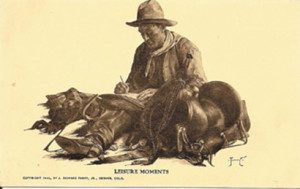
Ralph Russell Doubleday
A number of rodeo postcards were made from the rodeo photographs of Ralph Russell Doubleday who began his career creating stereoviews for Underwood & Underwood. Doubleday started his own company when pictures of rodeos gained popularity. Shown here are two Doubleday real photo rodeo cards copyrighted in the early 1920s. In both examples, he’s caught the performers in action. In one view, the booted showman jumps through his twirling rope, while in the second view, a stunt rider “stands” horizontal to his horse while working the rope. Difficult stunts and impressive photos!
Easier for the collector to find are cards Curt Teich made from Doubleday’s photos. Over 30 million postcards of his work were produced, which earned him the name Rodeo Postcard King.
Oren Arnold
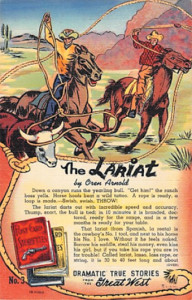 Colorful cards from the ‘linen’ era (1930-1945) that have caught the eye of many collectors are the Post Card Storiettes. This series consisted of 18 different cards, each illustrated in colorful, magazine style art. The stories on the cards were said to be true and taken from regional lore, written by Oren Arnold in just 250 words.
Colorful cards from the ‘linen’ era (1930-1945) that have caught the eye of many collectors are the Post Card Storiettes. This series consisted of 18 different cards, each illustrated in colorful, magazine style art. The stories on the cards were said to be true and taken from regional lore, written by Oren Arnold in just 250 words.
Arnold, born in Texas in 1900, made his home in Phoenix, AZ in 1932 where he worked as an editor and free-lance writer. His first book was Superstition’s Gold published in 1934. Currently there are 18 titles by Arnold listed on Goodreads.
Retailers saw the sales potential for these Post Card Storiettes and nearly 2,500,000 were ordered from the advance proofs. The cards were manufactured by Curt Teich. Lollesgard Specialty Co., of Tucson, AZ, one of the larger independent publishers at the time had control over the cards. In today’s market, these cards sell on average from $3 to $8 each depending on a dealer’s price and region. It seems to be easier to acquire a complete set now than it was 10 or 15 years ago.
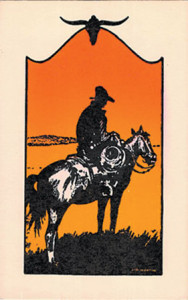 Morris. Parry. Doubleday. Arnold. These are only four of the hundreds of artists who created western-themed postcards. You can find postcards such as those shown here as well as other western-themed memorabilia at the upcoming show to be held on January 15 and 16 at the Jefferson County Fairgrounds Exhibit Hall located at 15200 W. Sixth Ave., Golden. Show hours are 11:00 to 7:00 on Friday and 9:30 to 4:30 on Saturday. Admission is $5.00 (children 12 and under and seniors over 85 are free).
Morris. Parry. Doubleday. Arnold. These are only four of the hundreds of artists who created western-themed postcards. You can find postcards such as those shown here as well as other western-themed memorabilia at the upcoming show to be held on January 15 and 16 at the Jefferson County Fairgrounds Exhibit Hall located at 15200 W. Sixth Ave., Golden. Show hours are 11:00 to 7:00 on Friday and 9:30 to 4:30 on Saturday. Admission is $5.00 (children 12 and under and seniors over 85 are free).
So gather the cowpokes and mosey on over to the Denver Postcard and Paper Show. You’ll have a romping good time.
If you’d like more information about the show or you have postcards to sell, contact Dede at 303-667-6212.
You can also visit the web site at www.DenverPostcardShow.com or on Facebook at https://www.facebook.com/DenverPostcardShow/

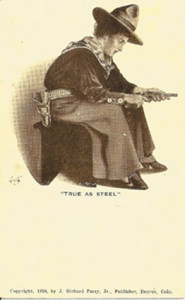
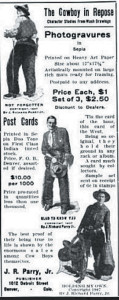
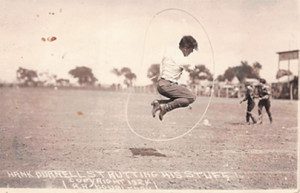
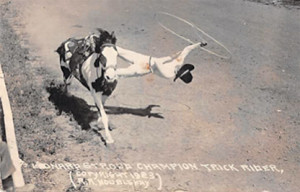
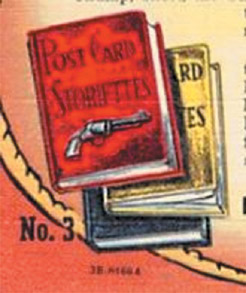














Follow Us